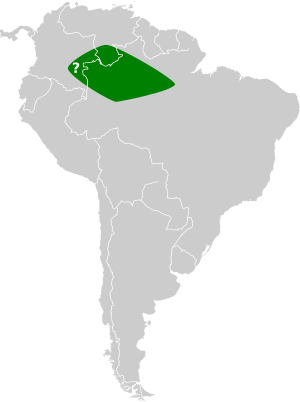Ega long-tongued bat facts for kids
Quick facts for kids Ega long-tongued bat |
|
|---|---|
| Conservation status | |
| Scientific classification | |
| Genus: |
Scleronycteris
|
| Species: |
ega
|
 |
|
The Ega long-tongued bat (Scleronycteris ega) is a small bat species. It is found in parts of northwestern Brazil and southern Venezuela. This bat is the only species in its group, which means it is monotypic within its genus. This makes it quite unique!
Contents
About the Ega Long-Tongued Bat
The Ega long-tongued bat is a fascinating creature. It was first described by a scientist named Oldfield Thomas in 1912. These bats are part of the family called Phyllostomidae, which includes many different types of bats found in the Americas.
What Does It Look Like?
These bats are quite small. They have a long snout and, as their name suggests, a very long tongue. This special tongue helps them reach their food. Their fur is usually a dark brown or grayish color. Like all bats, they have wings made of skin stretched between their long fingers and body.
Where Does It Live?
The Ega long-tongued bat lives in tropical areas. You can find them in the rainforests of northwestern Brazil and southern Venezuela. They prefer humid environments where their food sources are plentiful. Their habitat often includes dense forests near rivers or other water sources.
What Does It Eat?
The long tongue of the Ega long-tongued bat gives us a big clue about its diet! These bats are nectar-feeders. This means they mostly drink nectar from flowers, just like hummingbirds. They also eat pollen, which gives them important nutrients. Sometimes, they might eat small insects too. By visiting flowers, these bats help pollinate plants, which is very important for the ecosystem.
Why Is It Special?
One of the most special things about the Ega long-tongued bat is that it's the only species in its genus, Scleronycteris. This means there are no other living bats that are closely related enough to be in the same group. This makes it a unique branch on the bat family tree. Its long tongue is also a special adaptation for its nectar-feeding diet.
Is It Endangered?
The conservation status of the Ega long-tongued bat is listed as "Data Deficient" (DD) by the IUCN. This means scientists don't have enough information about this bat to know if its population is growing, shrinking, or staying the same. More research is needed to understand how many Ega long-tongued bats there are and what threats they might face. Protecting their rainforest habitat is important for their survival.
See Also
- In Spanish: Scleronycteris ega para niños


